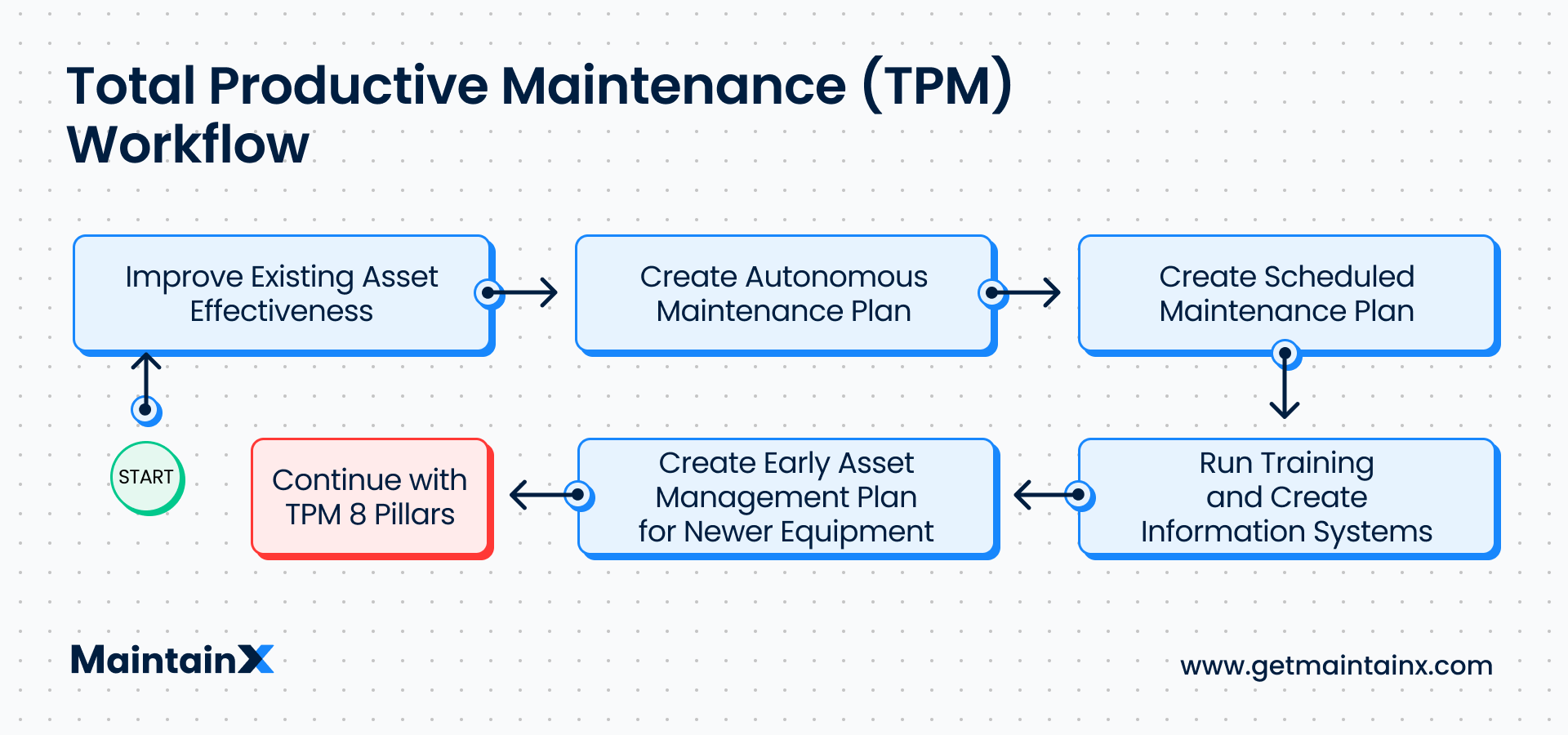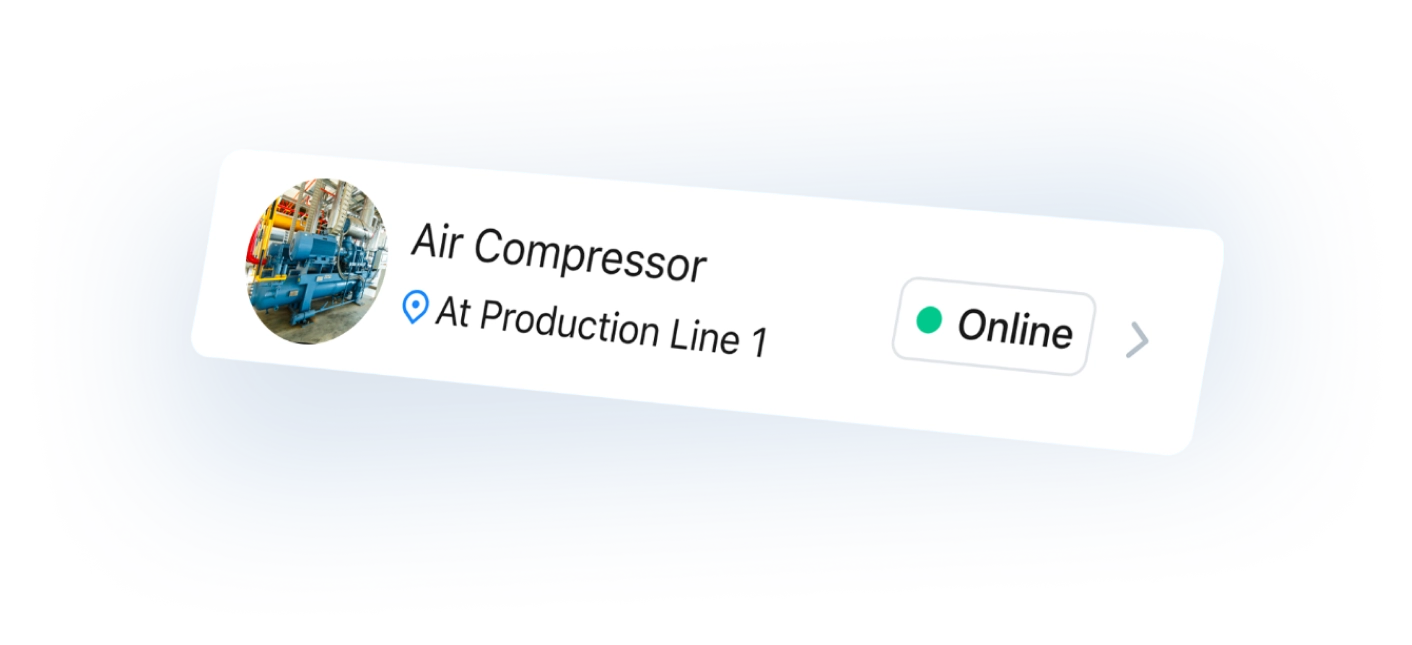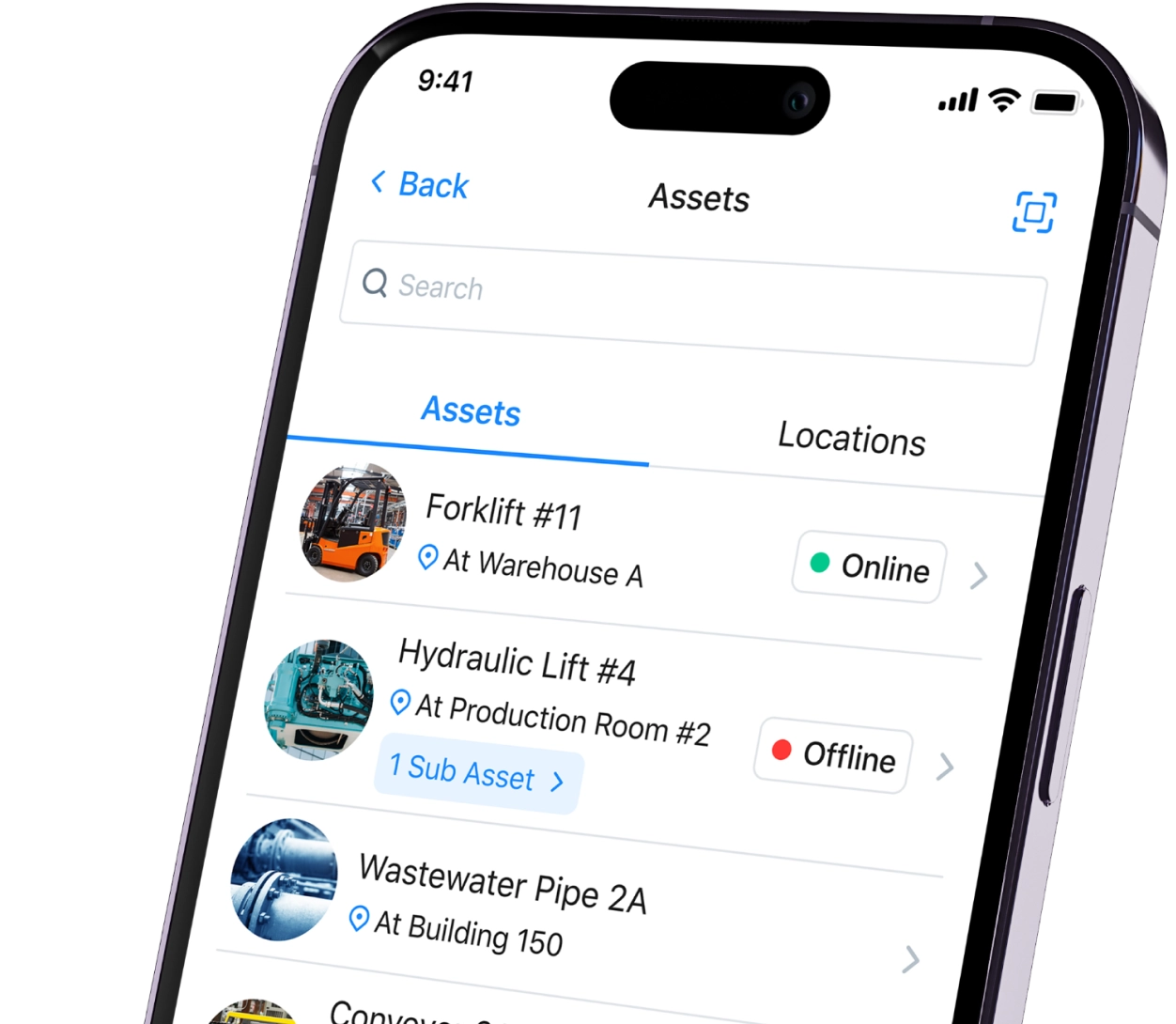A single machine breakdown in manufacturing can derail production and escalate costs in seconds. The costs from these disruptions add up over time. Just one hour of unplanned downtime costs $25,000 on average and for larger organizations, this number reaches $500,000.
Total productive maintenance (TPM) prevents these setbacks with a proactive approach designed to keep every machine and tool performing at its peak. However, TPM extends beyond basic upkeep. A well-thought-out TPM strategy creates a foundation for operational efficiency that helps facilities reduce downtime, achieve production targets, and lower repair costs.
We'll break down the core principles of TPM, an eight-pillar framework for implementing TPM, and how it impacts overall equipment effectiveness (OEE). You'll see exactly how TPM prevents costly equipment failures, boosts productivity, and builds reliability across your entire production process.
Key takeaways
- Total productive maintenance is a proactive maintenance strategy that involves all employees, not just the maintenance department, to maximize equipment effectiveness and reduce downtime.
- The methodology builds on the 5S foundation and the eight pillars of TPM, including autonomous maintenance, planned maintenance, and focused improvement.
- Successful total productive maintenance implementation directly improves overall equipment effectiveness by targeting the six big losses common for manufacturers, such as breakdowns, setup time, and quality defects.
- Implementing total productive maintenance requires a phased approach, starting with preparation and a pilot program, to manage change and ensure buy-in from all levels of your organization.
What is total productive maintenance?
Total productive maintenance is a comprehensive maintenance strategy that involves all employees, not just maintenance technicians, in keeping production equipment at peak performance. Total productive maintenance combines preventive maintenance, employee training, and continuous improvement to maximize equipment effectiveness while reducing downtime in manufacturing operations.
TPM improves equipment effectiveness by involving all employees in maintenance tasks. Equipment operators and maintenance managers help with daily checks, simple repairs, and preventive actions rather than relying only on technicians.
The methodology also uses planned maintenance schedules to address equipment needs before problems develop. By monitoring machine performance, your maintenance team identifies patterns and makes small adjustments to improve speed, quality, and reliability. This proactive approach reduces equipment failures and helps maximize production output.
The result is consistent quality and fewer delays in production processes. These improvements significantly enhance your OEE.

The three core concepts of total productive maintenance
Unlike reactive maintenance, which fixes problems after they happen, TPM aims to prevent issues before they occur. Three key ideas drive this philosophy:
1. Proactive and preventive maintenance
TPM uses regular, planned maintenance tasks to stop problems before they cause downtime. Equipment runs consistently, cutting unexpected failures and the repair bills that follow.
2. Employee involvement at all levels
TPM requires input and action from everyone, not just your key maintenance personnel. All employees actively participate in routine inspections, cleaning, and basic maintenance to keep equipment in optimal condition. When everyone gets involved in TPM, it creates a sense of ownership—operators and other employees start catching problems before they become expensive failures.
3. Zero loss
TPM sets a target goal of zero losses. This target includes zero breakdowns, zero defects, and zero accidents. By working together to prevent these major losses, your team keeps your machinery in prime operating condition for longer.
The history and evolution of total productive maintenance
Total productive maintenance originated in Japan in the 1950s as an evolution of preventive maintenance practices from the United States. Initially, maintenance was a reactive process, where teams only made repairs after a breakdown occurred. As manufacturing processes became more complex, the need for a more proactive approach led to the development of preventive maintenance, which involved scheduled upkeep.
Nippondenso, a supplier to Toyota, further refined the concept in the late 1960s. They expanded on preventive maintenance by empowering machine operators to take ownership of routine maintenance tasks for their own equipment. This shift marked the birth of TPM, integrating maintenance into the manufacturing process and involving employees at all levels.
The goal was no longer just to prevent failures but to create a culture of continuous improvement aimed at eliminating all production losses. Today, TPM remains a cornerstone of lean manufacturing and operational excellence worldwide.
The 5S foundation for total productive maintenance success
The 5S methodology will help your team establish a strong foundation for total productive maintenance before implementing the eight pillars of TPM. 5S is a workplace organization system that improves efficiency, safety, and effectiveness in manufacturing facilities.
Each "S" represents a specific step in the process:
- Sort (Seiri): Remove all unnecessary items from the workspace, leaving only the tools and materials required for daily operations. This reduces clutter and makes it easier to find what you need.
- Set in Order (Seiton): Arrange the remaining items logically so they are easy to access and return. This step minimizes wasted time searching for tools or parts.
- Shine (Seiso): Clean the workspace and equipment regularly. This serves as a form of inspection, helping you identify issues like leaks, cracks, or loose parts.
- Standardize (Seiketsu): Create standard procedures for the first three tasks to ensure consistency. Visual aids, checklists, and defined responsibilities help maintain order across all shifts.
- Sustain (Shitsuke): Make 5S a part of your team's daily routine and culture. This requires ongoing training, communication, and management support to ensure teams follow practices long-term.
A well-implemented 5S program creates the organized and disciplined environment necessary for the more advanced practices of TPM to succeed.
The eight pillars of a total productive maintenance program
The eight pillars of TPM build on the core concepts of total productive maintenance by outlining specific strategies to achieve the key goals specified by these concepts. Collectively, these pillars encourage proactive strategies that prevent breakdowns, reduce waste, and increase productivity. Each pillar also plays a role in ensuring equipment reliability, safety, and continuous operational improvement.
Here is an overview of each of the eight pillars:
1. Autonomous maintenance
In this pillar, machine operators take care of basic upkeep on their own equipment. Operators are responsible for cleaning, inspecting, and performing simple maintenance tasks, such as lubricating moving parts or tightening loose bolts. They do not need to contact maintenance personnel for these specific issues.
Autonomous maintenance helps operators become more familiar with their machines and increases the likelihood that operators will catch emerging issues well ahead of a breakdown.
2. Planned maintenance
Planned maintenance involves scheduling regular checkups and repairs to keep machines running smoothly. Planning these maintenance activities prevents unexpected breakdowns and reduces the risk of costly downtime. This process often requires the expertise of a specialized technician to accurately assess equipment needs and perform necessary maintenance tasks.
3. Quality maintenance
The quality maintenance pillar focuses on preventing potential product defects due to mechanical errors. Employees on your production line closely monitor equipment during production to watch for anything that might affect product quality. They then perform minor adjustments or inform maintenance technicians of any major issues if found.
4. Focused improvement
Focused improvement involves identifying specific challenges that hinder productivity and efficiency based on the combined opinions of a cross-functional team. For example, production staff identify bottlenecks and quality assurance specialists check that results meet standards. The goal is to incrementally identify and resolve small problems to achieve large-scale improvements over time.
5. Early equipment management
Early equipment management means using insights from past operational and maintenance tasks to guide the setup and design of new equipment. Engineers and maintenance teams install or build simpler and more dependable machines by using lessons learned.
A computerized maintenance management system (CMMS) makes it easier to access and understand this data. These tools help you organize maintenance records, track equipment performance, and highlight trends, making it simpler to analyze past issues to improve future plans.
6. Education and training
With proper training, workers learn how their equipment performs, how to make minor repairs, and how to spot potential issues. This knowledge allows them to help keep machines in good condition and improve overall equipment performance.
7. Safety, health, and environment
This pillar creates safer, healthier workspaces through safety measures that prevent accidents and reduce environmental impact.
8. Total productive maintenance in administrative departments
One of the core principles of TPM is the involvement of all employees. This philosophy extends to your administrative teams. Administrative functions, like scheduling, inventory management, and documentation, all contribute to the success of your TPM program.
Administration's involvement in TPM means that materials arrive as needed and records stay accurate.
Six losses that a total productive maintenance program prevents
A TPM program prevents losses that disrupt productivity, product quality, and equipment operation. By addressing these losses, TPM keeps processes efficient. Here are the six key losses that TPM helps you avoid:
1. Breakdown losses
Breakdown losses occur when machines suddenly fail and need repairs. TPM prevents these issues by scheduling regular maintenance and closely monitoring equipment health. By fixing small issues, like loose parts or worn bearings, TPM stops them from turning into serious breakdowns.
2. Setup and adjustment losses
Setup and adjustment losses happen when machines take too long to prepare for production, often due to time spent switching between products or adjusting machine settings. TPM tackles this challenge by creating efficient and standardized setup routines, training staff on exact steps, and encouraging consistent settings.
3. Idling and minor stoppage losses
Idling and minor stoppage losses refer to brief pauses in machine operation that don't require major repairs but halt production for a short time. Although each stoppage might last only a few seconds or minutes, it adds up over time and reduces overall productivity.
TPM addresses these losses by helping you identify common causes of these short pauses and training operators on how to fix them on the spot.
4. Reduced speed losses
Reduced speed losses occur when machines operate below their top speed due to aging parts, poor lubrication, improper settings, or another issue. TPM prevents this problem by enforcing routine maintenance and fine-tuning that keeps machines running optimally for longer.
5. Quality defects and rework
Sometimes, products don't meet quality standards due to poor machine calibration or worn-out parts. TPM reduces this risk by ensuring machines are consistently calibrated, cleaned, and equipped with high-quality parts.
This way, machines produce quality items consistently, which reduces waste and saves time by minimizing the need to redo work.
6. Startup losses
Startup losses occur when machines waste time and materials during warm-ups or initial runs. TPM reduces these instances by setting up standard routines for smoother startups and training operators to identify early issues. As a result, startup times are shorter, and machines reach full production sooner.
The importance of overall equipment effectiveness in the total productive maintenance process
OEE measures how well a machine or system works compared to its full potential. Because OEE highlights where teams are not using equipment to its full capacity, it is important in implementing the TPM process. High OEE means that equipment operates efficiently, runs reliably, and produces high-quality output—all indicators of TPM success.
The formula to calculate OEE is:
Overall Equipment Effectiveness = Availability x Performance x Quality
Each part of the formula focuses on a key area:
- Availability measures the percentage of time the equipment is available for use.
- Performance looks at how fast the equipment operates compared to its maximum speed.
- Quality shows the percentage of products that meet quality standards.
For example, suppose a machine operates eight hours a day with 30 minutes of downtime, runs at 90% of its maximum speed, and produces 98% of items within quality standards. In this case, you would calculate OEE by finding availability as 7.5 hours / 8 hours = 93.75%, performance (90%), and quality (98%).
Multiplying these (93.75% x 90% x 98%) gives an OEE of 82.7%.
How to implement total productive maintenance
TPM implementation can be broken down into four essential steps. Stick to this sequence and you'll avoid the chaos that derails most teams.
1. Preparation
Start by defining what you want to achieve with TPM. Defining your objectives will provide key guidelines to set the foundation for the rest of your implementation process.
Identify key department members, such as maintenance supervisors, production managers, and quality assurance specialists, to form a TPM team. Then, provide guidelines to ensure everyone on your team understands their role in the process.
This phase includes gathering baseline data on current equipment performance and maintenance history to measure improvement over time. Leveraging a CMMS to streamline data collection and ensure accurate tracking makes this phase easier.
Keys to success:
- Hold a kickoff meeting to clarify roles and communicate the team's initial goals.
- Document current maintenance processes for reference and comparison if they're not already in your maintenance management system.
- Assign team leaders to facilitate smooth communication across departments.
- Plan for any initial costs, such as training or equipment, to avoid surprises later.
2. Introduction
In this phase, you can introduce TPM concepts to everyone in your facility and build a sense of purpose around the program. Start by hosting training sessions to explain TPM goals, the eight pillars, and how everyone contributes to achieving success.
Ensure you clearly explain how TPM directly impacts their roles and benefits them, such as by improving work efficiency or reducing equipment downtime.
A good way to start is by selecting a pilot area to apply initial TPM strategies. This helps iron out any issues before a facility-wide rollout and demonstrates the impact the new program will have.
Keys to success:
- Organize interactive sessions where employees can ask questions and get hands-on demonstrations.
- Create visual materials like posters or signs that explain TPM processes clearly.
- Set realistic expectations for the pilot area and adjust based on initial feedback.
- Highlight how their efforts contribute to your organization's broader TPM goals.
3. Implement the eight pillars
During this phase, apply each of the eight TPM pillars throughout your facility. Begin with manageable goals and address one pillar at a time to avoid overwhelming your team. Track pillar implementation progress so your team sees the results of their effort.
Keys to success:
- Encourage employees to record observations about equipment performance in your maintenance management system for continuous insights.
- Assign mentors for each pillar to provide guidance and answer questions as new practices are adopted.
- Implement a simple feedback system so employees can suggest adjustments as needed and feel like they're part of the process.
- Set short-term and long-term goals for each pillar to maintain steady progress.
4. Consolidation
The consolidation phase is when TPM becomes a routine part of operations. Schedule regular reviews with the team help identify challenges, improve strategies, and keep TPM at the forefront of daily activities.
Continue to provide training to keep employee skills up to date. Training also helps maintain the momentum gained in earlier phases.
Keys to success:
- Hold monthly employee check-ins to maintain momentum and address emerging issues.
- Use data visualization to show progress and make adjustments more transparent.
- Celebrate individual and team milestones to keep motivation high.
- Integrate TPM metrics into performance reviews to reinforce commitment to the program.
Benefits of implementing a total productive maintenance program
TPM offers clear advantages for manufacturing teams, including higher productivity, reduced downtime, and lower maintenance costs. Here are five ways TPM benefits your operations:
1. Improved equipment reliability and availability
TPM increases equipment reliability and uptime by focusing on proactive and preventive maintenance tasks. It encourages teams to inspect, clean, and maintain machines before issues arise, reducing unexpected breakdowns and keeping machines running smoothly.
For Wauseon Machine, implementing TPM with the help of MaintainX led to a 6% improvement in their OEE over 16 months. The platform provided valuable features like meter-based scheduling that helped Wauseon's team perform maintenance precisely when needed.
2. Reduced maintenance costs
TPM reduces maintenance costs by promoting routine, low-cost maintenance actions instead of waiting for major repairs. By identifying small issues early, your facility avoids costly repairs and extends the lifespan of equipment.
3. Increased productivity and efficiency
TPM helps your team reduce downtime and improve equipment efficiency, which boosts productivity. With TPM methods like quick setups, regular inspections, and streamlined processes, machines operate longer without interruptions. Therefore, employees complete tasks faster and with fewer delays.
4. Enhanced product quality
Having a regular maintenance schedule improves product quality by ensuring equipment runs at optimal conditions. Machines in good working order produce fewer defects, which leads to consistently higher-quality products and better customer satisfaction.
5. Improved safety and employee morale
TPM improves safety by emphasizing maintenance tasks that prevent equipment-related hazards. Safe, well-maintained machines reduce the risk of accidents, and employees work confidently without worrying about malfunctioning equipment.
The common challenges of implementing total productive maintenance
TPM implementation often faces these common challenges that slow adoption across manufacturing facilities:
- Employee resistance: Workers may prefer familiar routines over new maintenance procedures
- Limited resources: Budget constraints and time pressures hinder proper training and tool deployment
- Delayed results: TPM benefits take time to show, making it hard to maintain momentum
However, proactive strategies help maintenance managers overcome these obstacles and ensure successful TPM adoption.
How to address resistance to change
Employees may feel unsure about new procedures or prefer familiar routines. To overcome this, clearly and frequently communicate the benefits of any changes, and include team members in planning. By explaining the benefits of TPM and addressing concerns directly, you build trust and encourage acceptance.
Build support through training and resources
For TPM to succeed, teams need specific training on maintenance procedures and regular access to necessary tools and equipment. Ongoing training helps employees feel confident in using TPM methods effectively.
Also, providing resources like maintenance scheduling software and condition-monitoring devices supports TPM by allowing employees to perform tasks accurately and consistently.
The future of total productive maintenance
TPM is changing rapidly as Industry 4.0 technologies become more common in manufacturing. TPM processes often include advanced tools like artificial intelligence (AI) and the Internet of Things (IoT) to make equipment monitoring more accurate and efficient.
Take predictive maintenance and the way it’s transforming how teams work. This strategy allows maintenance staff to quickly track developing equipment issues and respond almost immediately. Teams attach IoT sensors to machinery, and AI tools analyze data to predict when equipment maintenance is needed.
With predictive maintenance, you no longer need to rely on routine inspections or wait for failure before fixing equipment. Instead, you schedule maintenance based on real-time data.
Investing in a total productive maintenance process can greatly improve your manufacturing operations
TPM transforms reactive maintenance into a proactive, employee-driven approach that prevents costly breakdowns and maximizes equipment performance. Success requires the right digital tools to support continuous improvement across your operations.
MaintainX bridges the gap between outdated maintenance practices and modern operational excellence. Our mobile-first platform empowers frontline teams with real-time insights, AI-powered maintenance management, and the data visibility needed to keep the physical world running efficiently.
Ready to reduce unplanned downtime like our customers? Sign up for free and see how MaintainX transforms your TPM program in just three weeks.
FAQs About Total Productive Maintenance (TPM)
The eight pillars of TPM in manufacturing environments are: Autonomous Maintenance, Planned Maintenance, Quality Maintenance, Focused Improvement, Early Equipment Management, Education and Training, Safety/Health/Environment, and Administrative TPM. These pillars work together to improve equipment reliability and reduce unplanned downtime in asset-intensive operations.
While manufacturers know TPM for its eight pillars, five core principles guide it: involving all employees in maintenance, focusing on continuous improvement to eliminate losses, implementing planned maintenance, integrating quality into the process, and providing thorough education and training. These principles help your maintenance team shift from a reactive to a proactive culture.
TPM implementation timelines vary based on facility complexity and existing maintenance culture. A pilot program typically shows results in 3–6 months, while full enterprise rollout across multiple manufacturing sites requires 2–3 years to fully mature and integrate into daily operations.
Traditional preventive maintenance follows fixed schedules managed by maintenance departments. TPM is a holistic approach involving machine operators, engineers, and administrative staff in continuous equipment optimization, focusing on eliminating all losses rather than just preventing failures.
Manufacturing facilities measure TPM success through OEE, mean time between failures (MTBF), mean time to repair (MTTR), maintenance cost reduction, and safety incident decrease. ROI calculations compare operational improvements and cost savings against training and implementation investments, typically showing 20–30% improvement in key metrics.
See MaintainX in action





